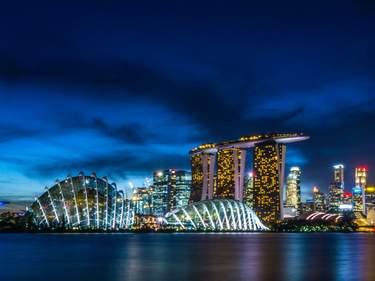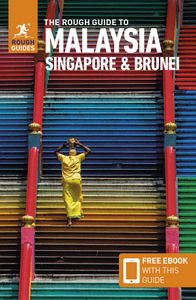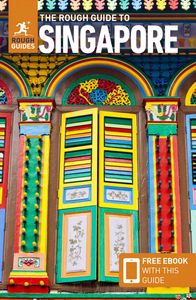Along River Valley Road
Fort Canning Park’s southern boundary is defined by River Valley Road, which skirts below the park from Hill Street. At its eastern end is the MICA Building, with shuttered windows in striking bright colours. Formerly the Hill Street Police Station, it is now home to the Ministry of Information, Communications and the Arts, plus the Ministry of Culture – and its central atrium houses several galleries majoring in Asian artworks.
The Singapore River
Little more than a creek, in the nineteenth century the Singapore River became the main artery of Singapore’s growing trade, and was clogged with bumboats – traditional cargo boats, the size of houseboats, with eyes painted on their prows as if to see where they were going. The boat pilots ferried coffee, sugar and rice to warehouses called godowns, where coolies loaded and unloaded sacks. In the 1880s the river itself was so busy it was practically possible to walk from one side to the other without getting your feet wet. Of course bridges were built across it as well, mostly endearingly compact and old-fangled, apart from the massive new Esplanade Bridge at the mouth of the river.
Walk beside the river today, all sanitized and packed with trendy restaurants and bars, some occupying the few surviving godowns, and it’s hard to imagine that in the 1970s this was still a working river. It was also filthy, and the river’s current status as one of the leading nightlife centres of Singapore ultimately originates in a massive clean-up campaign launched back then, which saw the river’s commercial traffic moved west to Pasir Panjang within the space of a few years. Several museums have sections exploring the role the river once played and the pros and cons of its transformation, with a particularly good discussion at the Asian Civilisations Museum, which states frankly: “[the project] also washed away … [the river’s] vibrant history as a trade waterway. Its newly cleaned waters now appeared characterless and sterile.” At least today various boat rides offer a view of the riverside restaurants and city skyline.
Sir Stamford Raffles
Despite living and working in a period of imperial arrogance and land-grabbing, Sir Stamford Raffles maintained an unfailing concern for the welfare of the people under his governorship, and a conviction that British colonial expansion was for the general good. He believed Britain to be, as Jan Morris says in her introduction to Maurice Collis’s biography of Raffles, “the chief agent of human progress… the example of fair Government”.
Fittingly for a man who was to spend his life roaming the globe, Thomas Stamford Raffles was born at sea on July 6, 1781 on the Ann, whose master was his father Captain Benjamin Raffles. By his fourteenth birthday, the young Raffles was working as a clerk for the East India Company in London, his schooling curtailed because of his father’s debts. Even at this early age, Raffles’ ambition and self-motivation was evident as he stayed up through the night to study and developed a hunger for knowledge which would later spur him to learn Malay, amass a vast treasure-trove of natural history artefacts and write his two-volume History of Java.
Raffles’ diligence and hard work showed through in 1805, when he was chosen to join a team going out to Penang, then being developed as a British entrepôt. Once in Southeast Asia, he enjoyed a meteoric rise: by 1807 he was named chief secretary to the governor in Penang. Upon meeting Lord Minto, the governor general of the East India Company in India, in 1810, Raffles was appointed secretary to the governor general in Malaya, a promotion quickly followed by the governorship of Java in 1811. Raffles’ rule of Java was liberal and compassionate, his economic, judicial and social reforms transforming an island bowed by Dutch rule.
Post-Waterloo European rebuilding saw the East Indies returned to the Dutch in 1816 – to the chagrin of Raffles. He was transferred to the governorship of Bencoolen in Sumatra, but not before he had returned home for a break. While in England he met his second wife, Sophia Hull (his first, Olivia, had died in 1814), and was knighted. Raffles and Sophia sailed to Bencoolen in early 1818. Once in Sumatra, Raffles found the time to study the region’s flora and fauna as tirelessly as ever, discovering Rafflesia arnoldii – “perhaps the largest and most magnificent flower in the world” – on a field trip. By now, Raffles felt strongly that Britain should establish a base in the Straits of Melaka and in late 1818 he was given leave to pursue this possibility. The following year he duly sailed to the southern tip of the Malay Peninsula, where his securing of Singapore was a daring masterstroke of diplomacy.
For a man whose name is inextricably linked with Singapore, Raffles spent a remarkably short time on the island. His last visit was in 1822; by August 1824, he was back in England. Awaiting news of a possible pension award from the East India Company, he spent his time founding the London Zoo. But the new life Raffles had planned never materialized. Days after hearing that a Calcutta bank holding £16,000 of his capital had folded, his pension application was refused; worse still, the Company was demanding £22,000 for overpayment. Three months later, in July 1826, the brain tumour that had caused Raffles headaches for several years took his life. He was buried at Hendon in north London with no memorial stone – the vicar had investments in slave plantations in the West Indies and was unimpressed by Raffles’ friendship with the abolitionist William Wilberforce. Only in 1832 was Raffles commemorated, with a statue in Westminster Abbey.
Stamford Road
From the northern edge of the Padang, Stamford Road zigzags its way past the Colonial District’s most important sight, the National Museum, passing three grand surviving examples of colonial commercial architecture: the 1930s Capitol Building, at the corner of North Bridge Road; Stamford House, built in 1904 at the corner of Hill Street; and the red-and-white Vanguard House, completed in 1908 at the corner of Armenian Street. Each has had an illustrious past – the Capitol Building as a theatre and cinema, Stamford House as an annexe to the Raffles Hotel (they were designed by the same architect) and as a major shopping centre, and Vanguard House as the headquarters of the Methodist Publishing House, then much later as home to the flagship store of the MPH bookshop chain. Despite regular maintenance that has kept their ornamented facades in tiptop condition, all now serve much more mundane roles hosting offices and run-of-the-mill shops.




















